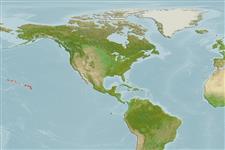Common names from other countries
Environment: milieu / climate zone / depth range / distribution range
Ekologi
Berasosiasi dengan karang; kisaran kedalaman 0 - 21 m (Ref. 2902). Tropical
Indo-Pacific: Oman, Philippines and Hawaii.
Length at first maturity / Size / Weight / umur
Maturity: Lm ? range ? - ? cm
Maximum depth from Ref. 101475. Found among rocks and rubble (Ref. 105268). Inshore detritus and deposit feeder (Ref. 98471). Associated with the commensal portunid crab Lissocarcinus orbicularis and parasitic eulimid snail M. nitidula (Ref. 105266). Associated with coral communities. Dwells on sediments between coral heads (Ref. 129602).
Life cycle and mating behavior
Kematangan | Reproduksi, perkembang biakan | Pemijahan | telur-telur | Fecundity | Larva
Members of the class Holothuroidea are gonochoric and have only one gonad. Spawning and fertilization are both external and some exhibit brooding. Life cycle: Embryos develop into planktotrophic larvae (auricularia) then into doliolaria (barrel-shaped stage) which later metamorphose into juvenile sea cucumbers.
rujukan utama
Acuan | Koordinator | mitra
Samyn, Y., D. Vandenspiegel and C. Massin. 2006. (Ref. 2900)
Status IUCN Red List (Ref. 130435)
status CITES (Ref. 108899)
Not Evaluated
Not Evaluated
ancaman kepada manusia
Harmless
penggunaan manusia
Perikanan: komersial
| FishSource | Sea Around Us
Alat, peralatan
informasi lanjut
Umur / Saiz
Pertumbuhan
panjang-berat
panjang-panjang
Morfologi
Larva
Kelimpahan
Sumber internet
Estimates based on models
Preferred temperature
(Ref.
115969): 24.4 - 28.4, mean 25.3 (based on 49 cells).
kategori harga
Unknown.
